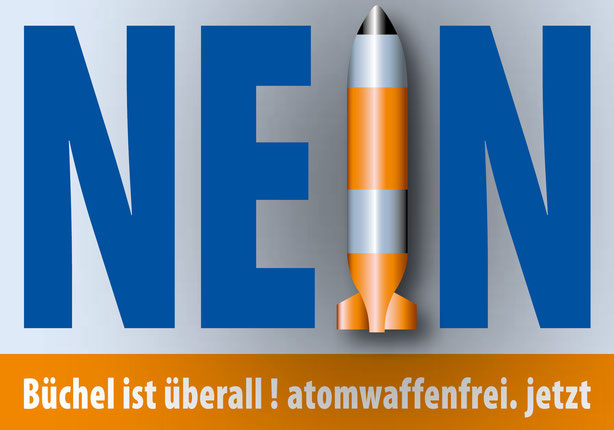
NATO Assembly Document Confirms US Nuclear Bombs Are in NL
Dutch News
(July 16, 2019) — One of the worst kept Dutch military secrets, that US nuclear weapons are being stored at the Dutch airbase in Volkel, has been been confirmed in a draft report to the NATO parliament. The information is contained in a document drawn up for discussion in the NATO parliamentary assembly on June 1, entitled “A New Era for Nuclear Deterrence? Modernisation, Arms Control and Allied Nuclear Forces.” [See document below — EAW]
The report was written by a member of the NATO parliamentary assembly’s defence committee and is not an official NATO document, the organisation told DutchNews.nl. “NATO PA reports are public documents based soley on open source information,” the NATO PA press service said. The report’s compiler discovered the slip and has removed the sentence in a new version of the report which was published on July 11.
The original document states that the US forward deploys 150 nuclear weapons for use by US and allied aircraft. These, it says, are stored at six US and European bases, including Volkel in the Netherlands and Kleine Brogel in Belgium as well as bases in Germany, Italy and Turkey.
The decision to maintain the non-strategic gravity bombs in Europe is due primarily to Russia’s maintenance of a large number of tactical nuclear weapons in its arsenal. The bombs are under US control and can only be released by the US president, the document states. Confirmation The Telegraaf said in 2013 that 22 US nuclear bombs are being stored in underground strong-rooms at the Volkel air base in Brabant and that former prime minister Ruud Lubbers confirmed the bombs are being kept at the base in a National Geographic documentary.
Papers leaked by Wikileaks in 2010 also seemed to suggest that US nuclear bombs were still kept in the Netherlands. The NATO parliamentary assembly acts as a link between NATO and its member parliaments and has five committees, including defence and security, which are charged with following major events in their fields and compiling reports for discussion

European Sites Where US Nuclear Weapons Held Inadvertently Revealed in NATO-linked Document
Ben Riley-Smith, US Editor / The Telegraph
LONDON (July 16, 2019) — The European sites where America’s nuclear weapons are stored has been inadvertently revealed in a document published by a NATO-linked body, according to Belgian media reports.
The document written by for the Defense and Security Committee of the NATO Parliamentary Assembly made passing reference to the roughly 150 US nuclear weapons being stored in Europe.
“These bombs are stored at six US and European bases—Kleine Brogel in Belgium, Büchel in Germany, Aviano and Ghedi-Torre in Italy, Volkel in The Netherlands, and Incirlik in Turkey,” one line read, according to the Belgian newspaper De Morgen.
The reference was reportedly contained in the original version of the document which was published in April but has since been removed in a final version which went out last week.
The document, titled “A new era for nuclear deterrence? Modernisation, arms control and allied nuclear forces,” was written by a Canadian senator.
A NATO official told The Washington Post the document was not from NATO itself – it was published by the group’s parliamentary assembly and added: “We do not comment on the details of NATO’s nuclear posture.”
The presence of US nuclear weapons in Europe acted as a deterrent to the Soviet Union during the Cold War and also meant European countries would not need to develop their own versions.
However for years the exact locations of the weapons have been a secret – though experts said their presence was widely known in the international community.
The faux pas was picked up by the European press. Dutch broadcaster RTL News ran an article headlined: “NATO reveals the Netherlands’s worst-kept secret.”
The reporting from De Morgen read: “Finally in black and white: There are American nuclear weapons in Belgium.”

The NATO Document
2019—A New Era for Nuclear Deterrence? Modernisation, Arms Control, and Allied Nuclear Forces
(11 July 2019) — The Alliance’s nuclear posture, which relies heavily on the strategic forces of the United States and, to a lesser extent, of France and the United Kingdom, is responding to a changing international environment and will likely change more in the not too distant future.
Recent Russian aggression has prompted NATO to reaffirm the role of its strategic forces as the ultimate guarantee of Allied security. The question of nuclear weapons posture and management, however, has been a relatively peripheral issue in recent debates about NATO’s new defence and deterrence policy.
Yet major international developments are renewing debate about the Alliance’s nuclear posture; particularly due to recent efforts by all nuclear states to modernise their forces, as well as the impending demise of the INF Treaty. Taken together, these factors pave the way for a potential new era of rearmament and a destabilising arms race.
Additional challenges to Allied nuclear deterrence are to come. The increasing reliance of nuclear weapons on cyber systems, in conjunction with technological developments such as hypersonic weapons, render the defence of strategic forces more difficult and significantly compresses the available response time.
Likewise, the continued proliferation of nuclear weapons raises the potential for accidents and thefts. NATO’s nuclear posture will be increasingly at the centre of Allied government and civilian debate in the coming months and years. As such, it is vital for NATO parliamentarians to be informed about the challenges of this complex issue.
The sufficiency of NATO’s nuclear posture today will be questioned if and when the INF Treaty falls into desuetude. As such, there will be a renewed debate about the correct mix of forces and negotiated arms control.
Posted in accordance with Title 17, Section 107, US Code, for noncommercial, educational purposes.